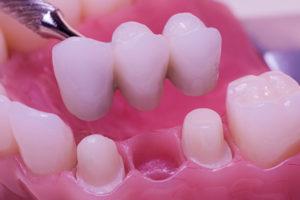What Is a Dental Bridge Made Of?

If you are looking to restore your smile, dentists have many missing teeth options at their disposal. Dentures are the most economical way to restore lost teeth — especially if the patient is missing most of their natural ones — but there are more comfortable options, like dental bridges or implants.
A dental bridge helps patients restore the functionality of their missing teeth and keep their proper alignment. This is particularly important, considering that teeth tend to move toward holes in the gaps in an attempt to close it. Leaving missing teeth unaddressed will eventually lead to misaligned teeth.
Missing teeth options 101: What are dental bridges made of?
Dental bridges can be made out of a wide range of materials, like porcelain, ceramics, zirconium and composites. The materials used to make these devices are often left for the patient to decide. Bridges often work in conjunction with crowns that are fitted on the two teeth closest to the gap on both sides. These are known as abutment teeth, and they serve as anchors for the device, keeping it securely in place.
The second part of a dental bridge consists of artificial teeth that are joined together. These are known as pontics.
The installation of a bridge often requires multiple visits to the dentist. During the initial appointment, the dentist will prepare the abutment teeth for the crown that will be used to keep the bridge in place. The dentist will then take an impression of the teeth and send the dimensions to a laboratory where the crowns and pontics are made. It typically takes two to three weeks for the lab to create the necessary prosthetics and send it back to the dentist.
During the second visit, the dentist will protect the abutment teeth with the newly made crowns, then connect the bridge to them. Once a dental bridge has been installed, it cannot be taken out without the help of a dentist.
Implant-supported bridges
Dental implants can also be used to support dental bridges, particularly when the patient is missing multiple teeth. The implants are surgically attached to the patient's jawbone, then it is given time to properly fuse. Once the implant is firmly secured with jawbone tissue, crowns are placed on the posts on the external-facing end of the implant.
One major benefit of implant-supported bridges is that the implant promotes healthy jawbone tissue. When a person is missing one or more of their natural teeth, the bone tissue around the area begins to deteriorate, since it is no longer needed. Implants mimic the functionality of natural teeth roots, so it helps prevent bone tissue loss.
What materials are used to make a bridge?
Bridges often contain a combination of metals and porcelain or ceramics. The ceramic or porcelain is typically bonded to metal to improve the strength and functionality of the bridge. Dental bridges can also be made completely from metals, even though that is not common.
Want to learn more about missing teeth options? Schedule a consultation with one of our dentists today!
Request an appointment in our Carmel dentist office here: https://www.carmelsmilesdentist.com.


